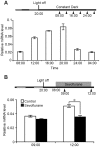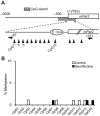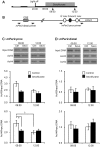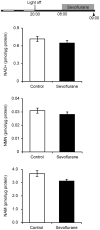Epigenetic suppression of mouse Per2 expression in the suprachiasmatic nucleus by the inhalational anesthetic, sevoflurane
- PMID: 24498074
- PMCID: PMC3909093
- DOI: 10.1371/journal.pone.0087319
Epigenetic suppression of mouse Per2 expression in the suprachiasmatic nucleus by the inhalational anesthetic, sevoflurane
Abstract
Background: We previously reported that sevoflurane anesthesia reversibly suppresses the expression of the clock gene, Period2 (Per2), in the mouse suprachiasmatic nucleus (SCN). However, the molecular mechanisms underlying this suppression remain unclear. In this study, we examined the possibility that sevoflurane suppresses Per2 expression via epigenetic modification of the Per2 promoter.
Methods: Mice were anesthetized with a gas mixture of 2.5% sevoflurane/40% oxygen at a 6 L/min flow for 1 or 4 h. After termination, brains were removed and samples of SCN tissue were derived from frozen brain sections. Chromatin immunoprecipitation (ChIP) assays using anti-acetylated-histone antibodies were performed to investigate the effects of sevoflurane on histone acetylation of the Per2 promoter. Interaction between the E'-box (a cis-element in the Per2 promoter) and CLOCK (the Clock gene product) was also assessed by a ChIP assay using an anti-CLOCK antibody. The SCN concentration of nicotinamide adenine dinucleotide (NAD(+)), a CLOCK regulator, was assessed by liquid chromatography-mass spectrometry.
Results: Acetylation of histone H4 in the proximal region of the Per2 promoter was significantly reduced by sevoflurane. This change in the epigenetic profile of the Per2 gene was observed prior to suppression of Per2 expression. Simultaneously, a reduction in the CLOCK-E'-box interaction in the Per2 promoter was observed. Sevoflurane treatment did not affect the concentration of NAD(+) in the SCN.
Conclusions: Independent of NAD(+) concentration in the SCN, sevoflurane decreases CLOCK binding to the Per2 promoter E'-box motif, reducing histone acetylation and leading to suppression of Per2 expression.
Conflict of interest statement
Figures





References
-
- Forrest JB, Rehder K, Goldsmith CH, Cahalan MK, Levy WJ, et al. (1990) Multicenter study of general anesthesia. I. Design and patient demography. Anesthesiology 72: 252–261. - PubMed
-
- Levy WJ (1984) Clinical anaesthesia with isoflurane. A review of the multicentre study. Br J Anaesth 56 Suppl 1101S–112S. - PubMed
-
- Brown BR, Frink EJ (1993) The safety of sevoflurane in humans. Anesthesiology 79: 201–202; author reply 202–203. - PubMed
-
- Sakamoto A, Imai J, Nishikawa A, Honma R, Ito E, et al. (2005) Influence of inhalation anesthesia assessed by comprehensive gene expression profiling. Gene 356: 39–48. - PubMed
-
- Kume K, Zylka MJ, Sriram S, Shearman LP, Weaver DR, et al. (1999) mCRY1 and mCRY2 are essential components of the negative limb of the circadian clock feedback loop. Cell 98: 193–205. - PubMed
Publication types
MeSH terms
Substances
LinkOut - more resources
Full Text Sources
Other Literature Sources

